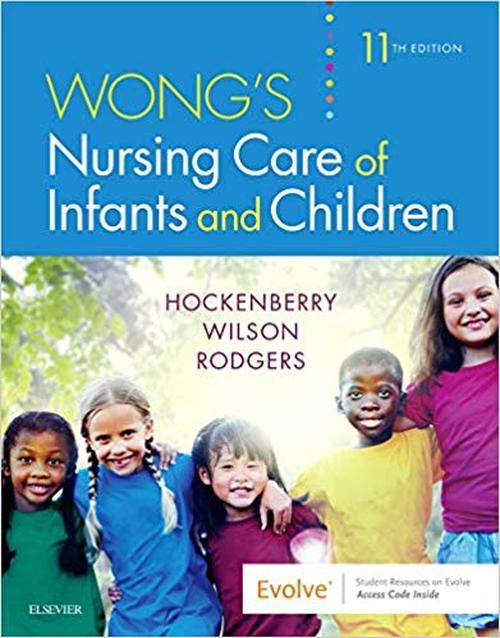Wong’s Nursing Care of Infants and Children, 11th Edition by Marilyn J. Hockenberry Test bank
$55.00
Wong’s Nursing Care of Infants and Children, 11th Edition by Marilyn J. Hockenberry Test bank
Test Bank Wong’s Nursing Care of Infants and Children, 11th Edition by Marilyn J. Hockenberry
Chapter 01: Perspectives of Pediatric Nursing
Hockenberry: Wong’s Nursing Care of Infants and Children, 11th Edition
MULTIPLE CHOICE
- What is the major cause of death for children in the United States?
- Heart disease
- Childhood cancer
- Injuries
- Congenital anomalies
ANS: C
Unintentional injuries (accidents) are the leading cause of death after age 1 year through adolescence. The leading cause of death for those younger than 1 year is congenital anomalies, and childhood cancers and heart disease cause a significantly lower percentage of deaths in children older than 1 year of age.
DIF: Cognitive Level: Understanding TOP: Nursing Process: Planning MSC: Client Needs: Health Promotion and Maintenance
- Parents of a hospitalized toddler ask the nurse, “What is meant by family-centered care?” The nurse should respond with which statement?
- Family-centered care reduces the effect of cultural diversity on the family.
- Family-centered care encourages family dependence on the health care system.
- Family-centered care recognizes that the family is the constant in a child’s life.
- Family-centered care avoids expecting families to be part of the decision-making process.
ANS: C
The three key components of family-centered care are respect, collaboration, and support. Family-centered care recognizes the family as the constant in the child’s life. The family should be enabled and empowered to work with the health care system and is expected to be part of the decision-making process. The nurse should also support the family’s cultural diversity, not reduce its effect.
DIF: Cognitive Level: Applying TOP: Nursing Process: Implementation MSC: Client Needs: Health Promotion and Maintenance
- Evidence-based practice (EBP), a decision-making model, is best described as which?
- Using information in textbooks to guide care
- Combining knowledge with clinical experience and intuition
- Using a professional code of ethics as a means for decision making
- Gathering all evidence that applies to the child’s health and family situation
ANS: B
EBP helps focus on measurable outcomes; the use of demonstrated, effective interventions; and questioning the best approach. EBP involves decision making based on the integration of the best research evidence combined with clinical expertise and patient values.
DIF: Cognitive Level: Remembering TOP: Nursing Process: Planning MSC: Client Needs: Safe and Effective Care Environment
- Which best describes signs and symptoms as part of a nursing diagnosis?
- Description of potential risk factors
- Identification of actual health problems
- Human response to state of illness or health
- Cues and clusters derived from patient assessment
ANS: D
Signs and symptoms are the cues and clusters of defining characteristics that are derived from a patient assessment and indicate actual health problems. The first part of the nursing diagnosis is the problem statement, also known as the human response to the state of illness or health. The identification of actual health problems may be part of the medical diagnosis. The nursing diagnosis is based on the human response to these problems. The human response is therefore a component of the nursing diagnostic statement. Potential risk factors are used to identify nursing care needs to avoid the development of an actual health problem when a potential one exists.
DIF: Cognitive Level: Understanding
TOP: Integrated Process: Communication and Documentation MSC: Client Needs: Safe and Effective Care Environment
- The nurse is talking to a group of parents of school-age children at an after-school program about childhood health problems. Which statement should the nurse include in the teaching?
- Childhood obesity is the most common nutritional problem among children.
- Immunization rates are the same among children of different races and ethnicity.
- Dental caries is not a problem commonly seen in children since the introduction of fluorinated water.
- Mental health problems are typically not seen in school-age children but may be diagnosed in adolescents.
ANS: A
When teaching parents of school-age children about childhood health problems, the nurse should include information about childhood obesity because it is the most common problem among children and is associated with type 2 diabetes. Teaching parents about ways to prevent obesity is important to include. Immunization rates differ depending on the child’s race and ethnicity; dental caries continues to be a common chronic disease in childhood; and mental health problems are seen in children as young as school age, not just in adolescents.
DIF: Cognitive Level: Applying TOP: Integrated Process: Teaching/Learning MSC: Client Needs: Health Promotion and Maintenance
- The nurse is planning care for a hospitalized preschool-aged child. Which should the nurse plan to ensure atraumatic care?
- Limit explanation of procedures because the child is preschool aged.
- Ask that all family members leave the room when performing procedures.
- Allow the child to choose the type of juice to drink with the administration of oral medications.
- Explain that EMLA cream cannot be used for the morning lab draw because there is not time for it to be effective.
ANS: C
The overriding goal in providing atraumatic care is first, do no harm. Allowing the child a choice of juice to drink when taking oral medications provides the child with a sense of control. The preschool child should be prepared before procedures, so limiting explanations of procedures would increase anxiety. The family should be allowed to stay with the child during procedures, minimizing stress. Lidocaine/prilocaine (EMLA) cream is a topical local anesthetic. The nurse should plan to use the prescribed cream in time for morning laboratory draws to minimize pain.
DIF: Cognitive Level: Applying TOP: Nursing Process: Planning MSC: Client Needs: Health Promotion and Maintenance
- Which situation denotes a nontherapeutic nurse–patient–family relationship?
- The nurse is planning to read a favorite fairy tale to a patient.
- During shift report, the nurse is criticizing parents for not visiting their child.
- The nurse is discussing with a fellow nurse the emotional draw to a certain patient.
- The nurse is working with a family to find ways to decrease the family’s dependence on health care providers.
ANS: B
Criticizing parents for not visiting in shift report is nontherapeutic and shows an under involvement with the parents. Reading a fairy tale is a therapeutic and age appropriate action. Discussing feelings of an emotional draw with a fellow nurse is therapeutic and shows a willingness to understand feelings. Working with parents to decrease dependence on health care providers is therapeutic and helps to empower the family.
DIF: Cognitive Level: Analyzing TOP: Integrated Process: Caring MSC: Client Needs: Psychosocial Integrity
- The nurse is aware that which age-group is at risk for childhood injury because of the cognitive characteristic of magical and egocentric thinking?
- Preschool
- Young school age
- Middle school age
- Adolescent
ANS: A
Preschool children have the cognitive characteristic of magical and egocentric thinking, meaning they are unable to comprehend danger to self or others. Young and middle school-aged children have transitional cognitive processes, and they may attempt dangerous acts without detailed planning but recognize danger to themselves or others. Adolescents have formal operational cognitive processes and are preoccupied with abstract thinking.
DIF: Cognitive Level: Understanding TOP: Nursing Process: Assessment MSC: Client Needs: Safe and Effective Care Environment
- The school nurse is assessing children for risk factors related to childhood injuries. Which child has the most risk factors related to childhood injury?
- Female, multiple siblings, stable home life
- Male, high activity level, stressful home life
- Male, even tempered, history of previous injuries
- Female, reacts negatively to new situations, no serious previous injuries
ANS: B
Boys have a preponderance for injuries over girls because of a difference in behavioral characteristics, a high activity temperament is associated with risk-taking behaviors, and stress predisposes children to increased risk taking and self-destructive behaviors.
Therefore, a male child with a high activity level and living in a stressful environment has the highest number of risk factors. A girl with several siblings and a stable home life is low risk. A boy with previous injuries has two risk factors, but an even temper is not a risk factor for injuries. A girl who reacts negatively to new situations but has no previous serious illnesses has only one risk factor.
DIF: Cognitive Level: Analyzing TOP: Nursing Process: Assessment MSC: Client Needs: Safe and Effective Care Environment
- An adolescent patient wants to make decisions about treatment options, along with his parents. Which moral value is the nurse displaying when supporting the adolescent to make decisions?
- Justice
- Autonomy
- Beneficence
- Nonmaleficence
ANS: B
Autonomy is the patient’s right to be self-governing. The adolescent is trying to be autonomous, so the nurse is supporting this value. Justice is the concept of fairness. Beneficence is the obligation to promote the patient’s well-being. Nonmaleficence is the obligation to minimize or prevent harm.
DIF: Cognitive Level: Analyzing TOP: Nursing Process: Evaluation MSC: Client Needs: Health Promotion and Maintenance
MULTIPLE RESPONSE
- Which responsibilities are included in the pediatric nurse’s promotion of the health and well-being of children? (Select all that apply.)
- Promoting disease prevention
- Providing financial assistance
- Providing support and counseling
- Establishing lifelong friendships
- Establishing a therapeutic relationship
- Participating in ethical decision making
ANS: A, C, E, F
The pediatric nurse’s role includes promoting disease prevention, providing support and counseling, establishing a therapeutic relationship, and participating in ethical decision making; a pediatric nurse does not need to establish lifelong friendships or provide financial assistance to children and their families. Boundaries should be set and clear.
DIF: Cognitive Level: Applying TOP: Nursing Process: Planning MSC: Client Needs: Health Promotion and Maintenance
- The nurse is conducting a teaching session for parents on nutrition. Which characteristics of families should the nurse consider that can cause families to struggle in providing adequate nutrition? (Select all that apply.)
- Homelessness
- Lower income
- Migrant status
- Working parents
- Single parent status
ANS: A, B, C
Families that struggle with lower incomes, homelessness, and migrant status generally lack the resources to provide their children with adequate food intake, nutritious foods such as fresh fruits and vegetables, and appropriate protein intake. Working parents and single parent status do not mean the families will struggle to provide adequate nutrition.
DIF: Cognitive Level: Applying TOP: Integrated Process: Teaching/Learning MSC: Client Needs: Health Promotion and Maintenance
- The nurse is preparing to complete documentation on a patient’s chart. Which should be included in documentation of nursing care? (Select all that apply.)
- Reassessments
- Incident reports
- Initial assessments
- Nursing care provided
- Patient’s response of care provided
ANS: A, C, D, E
The patient’s medical record should include initial assessments, reassessments, nursing care provided, and the patient’s response of care provided. Incident reports are not documented in the patient’s chart.
DIF: Cognitive Level: Applying
TOP: Integrated Process: Communication and Documentation MSC: Client Needs: Safe and Effective Care Environment
- Which actions by the nurse demonstrate over involvement with patients and their families? (Select all that apply.)
- Buying clothes for the patients
- Showing favoritism toward a patient
- Focusing on technical aspects of care
- Spending off-duty time with patients and families
- Asking questions if families are not participating in care
ANS: A, B, D
Actions that show over involvement include buying clothes for patients, showing favoritism toward a patient, and spending
off-duty time with patients and families. Focusing on technical aspects of care is an action that indicates under involvement, and asking questions if families are not participating in care indicates a positive action.
DIF: Cognitive Level: Analyzing TOP: Integrated Process: Caring MSC: Client Needs: Health Promotion and Maintenance
- Which are included in the evaluation step of the nursing process? (Select all that apply.)
- Determination if the outcome has been met
- Ascertaining if the plan requires modification
- Establish priorities and selecting expected patient goals
- Selecting alternative interventions if the outcome has not been met
- Determining if a risk or actual dysfunctional health problem exists
ANS: A, B, D
Evaluation is the last step in the nursing process. The nurse gathers, sorts, and analyzes data to determine whether (1) the established outcome has been met, (2) the nursing interventions were appropriate, (3) the plan requires modification, or (4) other alternatives should be considered. Establishing priorities and selecting expected patient goals are done in the outcomes identification stage. Determining if a risk or actual dysfunctional health problem exists is done in the diagnosis stage of the nursing process.
DIF: Cognitive Level: Understanding TOP: Nursing Process: Evaluation MSC: Client Needs: Health Promotion and Maintenance
- Which should the nurse teach to parents regarding oral health of children? (Select all that apply.)
- Fluoridated water should be used.
- Early childhood caries is a preventable disease.
- Dental caries is a rare chronic disease of childhood.
- Dental hygiene should begin with the first tooth eruption.
- Childhood caries does not happen until after 2 years of age.
ANS: A, B, D
Oral health instructions to parents of children should include use of fluoridated water and dental hygiene beginning with the first tooth eruption. In addition, early childhood caries is a preventable disease and should be included in the teaching session. Dental caries is a common, not rare, chronic disease of childhood. Childhood caries may begin before the first birthday.
DIF: Cognitive Level: Applying TOP: Integrated Process: Teaching/Learning MSC: Client Needs: Health Promotion and Maintenance
- The school nurse is explaining to older school children that obesity increases the risk for which disorders? (Select all that apply.)
- Asthma
- Hypertension
- Dyslipidemia
- Irritable bowel disease
- Altered glucose metabolism
ANS: B, C, E
Overweight youth have increased risk for a cluster of cardiovascular factors that include hypertension, altered glucose metabolism, and dyslipidemia. Irritable bowel disease and asthma are not linked to obesity.
DIF: Cognitive Level: Applying TOP: Integrated Process: Teaching/Learning MSC: Client Needs: Health Promotion and Maintenance
- The nurse is reviewing the Healthy People 2020 leading health indicators for a child health promotion program. Which are included in the leading health indicators? (Select all that apply.)
- Decrease tobacco use.
- Improve immunization rates.
- Reduce incidences of cancer.
- Increase access to health care.
- Decrease the number of eating disorders.
ANS: A, B, D
The Healthy People 2020 leading health indicators provide a framework for identifying essential components for child health promotion programs designed to prevent future health problems in our nation’s children. Some of the leading health indicators include decreasing tobacco use, improving immunization rates, and increasing access to health care. Reducing the incidence of cancer and decreasing the number of eating disorders are not on the list as leading health indicators.
DIF: Cognitive Level: Analyzing TOP: Nursing Process: Evaluation MSC: Client Needs: Health Promotion and Maintenance
- Which actions by the nurse demonstrate clinical reasoning? (Select all that apply.)
- Basing decisions on intuition
- Considering alternative action
- Using formal and informal thinking to gather data
- Giving deliberate thought to a patient’s problem
- Developing an outcome focused on optimum patient care
ANS: B, C, D, E
Clinical reasoning is a cognitive process that uses formal and informal thinking to gather and analyze patient data, evaluate the significance of the information, and consider alternative actions. Clinical reasoning is a complex developmental process based on rational and deliberate thought and developing an outcome focused on optimum patient care. Clinical reasoning is based on the scientific method of inquiry; it is not based solely on intuition.
DIF: Cognitive Level: Applying TOP: Nursing Process: Evaluation MSC: Client Needs: Safe and Effective Care Environment
COMPLETION
1. The nurse is determining if a newborn is classified in the low birth weight (LBW) category of less than 2500 g. The newborn’s weight is 5 pounds, 4 oz. What is the newborn’s weight in grams? Record your answer in a whole number.
ANS:
2386
Convert the 4 oz to a decimal by dividing 4 by 16 = Use pounds and divide by to get kg. Multiply by 1000 to convert to grams = 2386.
DIF: Cognitive Level: Applying TOP: Nursing Process: Implementation MSC: Client Needs: Health Promotion and Maintenance












Reviews
There are no reviews yet.